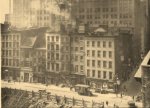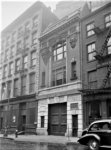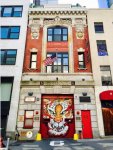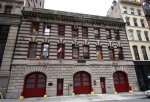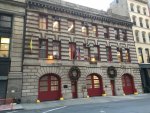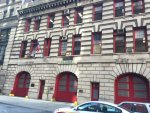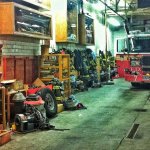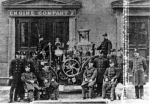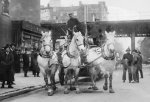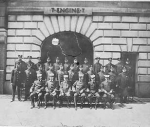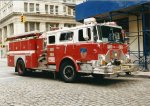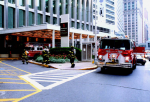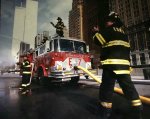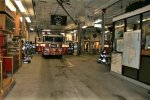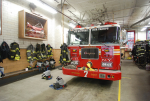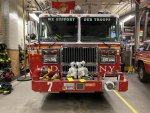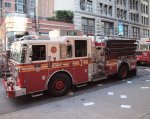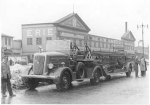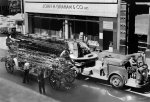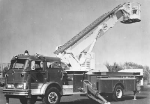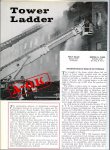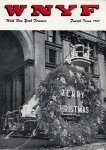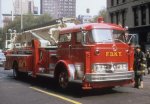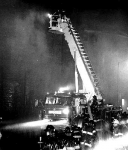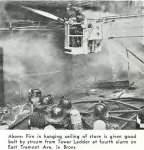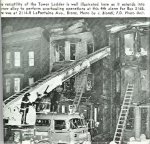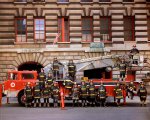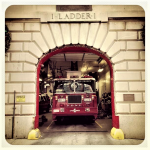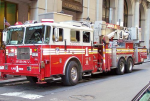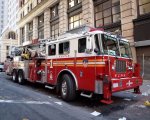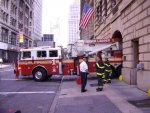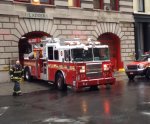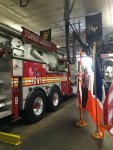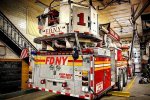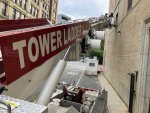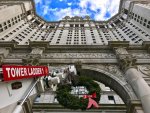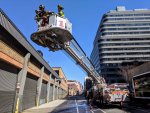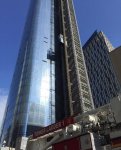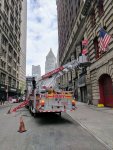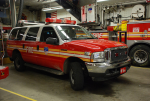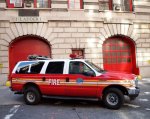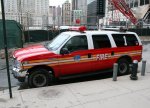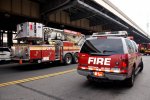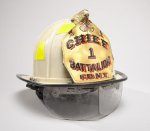You are using an out of date browser. It may not display this or other websites correctly.
You should upgrade or use an alternative browser.
You should upgrade or use an alternative browser.
FDNY and NYC Firehouses and Fire Companies - 2nd Section
- Thread starter mack
- Start date
Engine 7/Ladder 1/Battalion 1 (continued)
100 DUANE STREET ENGINE COMPANY NO. 7/HOOK & LADDER COMPANY NO. 1 FIREHOUSE - DESIGN/HISTORY
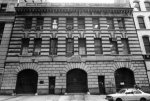
100-104 Duane Street, Borough of Manhattan.
Built 1904-05; architects Trowbridge & Livingston.
Landmark Site: Borough of Manhattan Tax Map Block 150, Lot 25.
On September 19, 1989, the Landmarks Preservation Commission held a public hearing on the proposed designation as Landmark of the Engine Company 7 /Ladder Company 1 Fire House, and the proposed designation of the related Landmark Site (Item No. 5). The hearing had been duly advertised in accordance with the provisions of law. Two witnesses testified in favor of the designation; four letters were received in support of the designation. No one spoke against the proposed designation.
DESCRIPTION AND ANALYSIS
Summary
The Engine Company No. 7/Hook & Ladder Company No. 1 Firehouse, designed in the Beaux-Arts style -- or what at the time was described as the "modem French" style -- by the prominent architectural firm of Trowbridge & Livingston and built in 1904-05, is a building of great architectural quality. The three-story firehouse's three-bay width was dictated by the two-bay requirement of an enlarged engine company and a third bay for a separate hook & ladder company. The architects created a facade remarkable for its symmetry and emphatic horizontality. It is visually unified by superimposed architectural elements drawn from early seventeenth-century French civic architecture: the boldly rusticated Indiana limestone ground story, the brick and raised limestone bands of the upper stories, the entablature and parapet. The seventeenth-century French architects adapted these elements from the urban palace facades of the Italian Renaissance.
In the often heroic execution of their mandated responsibilities, Engine Company No. 7 and Hook & Ladder Company No. 1, two of the city's oldest fire companies, share an honored place in the city's history. The companies, housed together since 1851, were sited in the northeast comer of City Hall Park. The new Duane Street location was chosen both for its proximity to the center of municipal government and to assure protection for the new skyscrapers going up adjacent to the park. This dynamic firehouse facade projects the strength and solidity associated with an arm of municipal government and is appropriate to the home of those dedicated to protecting the lives and property of the citizens of New York.
City Hall Park and its Neighborhood
In the seventeenth century the area that is now City Hall Park was part of the common fields north of the colonial settlement of New Amsterdam and then New York. By the end of the nineteenth century the park itself had become the location of numerous public buildings of varying architectural distinction housing a variety of municipal functions, from Mangin and Macomb's City Hall to the two firehouses on Chambers Street. To check this congestion and regain a semblance of park, a proposal was put forward to remove the buildings at the park's north end. The final scheme of 1895 called only for the retention of City Hall and the Tweed Court House. The functions of municipal government to be removed from the park were housed in new structures built across from or nearby the park: the Surrogate's Court/Hall of Records Building (1897-1906, a designated New York City Landmark), designed by John R. Thomas for the block on the north side of Chambers, west of Centre Street; the Municipal Building (1909-14, a designated New York City Landmark), designed by McKim, Mead & White to bridge Chambers Street east of Centre; and the firehouse (1904-05) at 100-104 Duane Street, designed by Trowbridge & Livingston for Engine Company No. 7 and Hook & Ladder Company No. 1, both formerly located in the northeast corner of City Hall Park.
Meanwhile, tall commercial buildings and skyscrapers were going up around City Hall Park. The earliest were those on that section of Park Row known as Printing House Square, on the park's east side (where Pace University now stands). The first tall buildings west of City Hall Park were the Postal Telegraph and Home Life Insurance Company Buildings (1892-94, a designated New York Landmark), fronting on Broadway between Murray and Warren Streets. In the same year the Mutual Reserve (also called the Langdon) Building, designed by William H. Hume & Son in 1894, opened on the northwest corner of Duane Street and Broadway. It was soon followed by several distinguished towers: the Dun Building (Harding & Gooch, 1898, now demolished) on the northeast corner of Broadway and Reade Street; Cass Gilbert's Broadway-Chambers Building (1899-1900, a designated New York City Landmark); and the Ungar/Barclay Building (Stockton B. Colt, 1902-05) on the southwest corner of Broadway and Duane Street. Certainly this new density of tall commercial structures, rising next to the older five-story buildings, required the presence of a Fire Department facility. The Duane Street location for this new, up-to-date firehouse was both close enough to still serve the civic center and was immediately adjacent to the new concentration of tall buildings just northwest of City Hall Park. The wide lot on the south side of Duane Street was purchased by the City on February 11, 1904.
HISTORY
Engine Company No. 7 and Hook & Ladder Co. No. 1
Hook & Ladder Company No. 1, one of the oldest in the Fire Department and the only company to retain the same numeral through the transition from a volunteer to a paid professional department in 1865, was in existence before the American Revolution; its members, along with the rest of the volunteer fire department, marched off to join the Continental Army. In 1786 the returning veterans and the interim volunteers were reorganized by the city's new Mayor, James Duane. Several years later Hook & Ladder Company No. 1 styled itself "Mutual" Hook & Ladder No. 1. Throughout its long history, both before and after the professional department was introduced, Hook & Ladder Company No. 1 has been housed in close proximity to the seat of municipal government. The company hung its hooks and ladders in the main ground story passageway of the predecessor City Hall (old Federal Hall) on Wall Street (the site of the Federal Hall National Memorial). The company was moved to the Bridewell in 1813 and subsequently to Whitehall Street. In 1830 it was at 24 Beaver Street where it remained until 1842 when it was moved to the basement of the old Dispensary at 26 Chambers Street in City Hall Park.
Engine Company No. 7, before 1865, was "Protector" Engine Company No. 22 in the volunteer department. 8 In 1840 this company was formed to run a large engine, "Old Junk," and was housed at Chambers and Centre Streets in City Hall Park -- perhaps in the basement of the old Dispensary also.9 On July 14, 1851, the Common Council appropriated money to construct a three-story building in City Hall Park to house two companies (subsequently Hose Company No. 28 was absorbed into Engine Company No. 7) under one roof for the first time: "Protector" Engine Company No. 22, then at 22 Chambers Street; and "Mutual" Hook & Ladder Company No. 1, then at 26 Chambers Street.
Both companies have played an important part in New York's history. John W. Towt, a leather merchant by trade as well as "Mutual" Hook & Ladder Company No. 1's foreman c.1828, made firemen's hats, devising a unique and functional design with a high, rounded crown and long rear brim. Towt purchased the first horse ever owned by the Fire Department; the horse pulled the hook and ladder wagon to fires in the neighborhoods most severely affected during the cholera epidemic of 1832, where many volunteers, who usually ran with the apparatus, feared to go. "Mutual" Hook & Ladder Company No. 1 participated in many civic ceremonies: in the firemen's display in Lafayette's honor in 1824 in front of City Hall; the funeral processions of Presidents John Quincy Adams and Andrew Jackson; and the official opening of the Croton Aqueduct on October 14, 1842. In December 1853 the crowd assembled in Franklin Square cheered as company members handed the young female employees down the ladders from the blazing Harper Brothers' paper warehouse.
But heroic deeds were often shaded with calamity. Many firemen perished in May of the following year when the walls of the burning W. T. Jennings' & Co. building at 231 Broadway collapsed. Although "Protector" Engine Company No. 22's district was different from Hook & Ladder No. 7's, there is no doubt that this company participated in putting out these and other fires in lower Manhattan. "Protector" Engine Company No. 22 was one of companies that commandeered the ferry to Brooklyn to extinguish the great blaze at 21 Fulton Street in 1842.
After the volunteer department was abolished in 1865, Hook & Ladder Company No. 1 and Engine Company No. 7 continued to be neighbors at 26 and 22 Chambers Street respectively. Entries in Engine Company No. 7's daily Journals indicate that telegraph messages from headquarters were received at Hook & Ladder Company No. 1 and brought over by a company member; likewise, messages from Engine Company No. 7 were taken over to 26 Chambers Street to be sent out.
Officers from either firehouse were often ordered to relieve one another in any temporary absence. The new professional department adopted a para-military regime; the firemen on duty resided at the firehouse. Horses had replaced the running firemen when the new heavier steam engines and longer, heavier ladders were introduced: the horses had to be fed, exercised and shod; and the boilers of the steam engines – a Clapp & Jones Steam Fire Engine, in the case of Engine Company No. 7 -- had to be maintained at a constant twenty pounds pressure. But this routine of readiness was often interrupted when the gong sounded and the apparatus rolled. At the end of the nineteenth century the greatest challenge facing the Fire Department was how to extinguish fires in tall buildings like those being erected adjacent to City Hall Park. On December 4, 1898, a spectacular, ten-alarm fire broke out in the five-story Rogers Peet clothing store at Warren Street and Broadway and, fanned by a stormy east wind, spread to the upper stories of the sixteen story Home Life Insurance Company Building next door and beyond to the top of the Postal Telegraph Building at Broadway and Murray Street. Both Hook & Ladder Company No. 1 and Fire Engine Company No. 7 fought the fire.
Front page material for a week and still news in the ensuing months, this fire raised two controversial issues: the effectiveness of fireproof construction in tall buildings; as well as the ability of the Fire Department to put out fires in tall buildings. Edward F. Croker, the Chief of the Fire Department, advocated building-height limitations for some time after the Rogers Peet and Home Life Insurance Company Building fire. A single steam fire-engine was unable to throw water effectively above the eighth story. Greater thrust could only be achieved when two or more engines were linked. For areas of the city where tall buildings were becoming the predominant building type, as they were around City Hall Park, there was concern that more apparatus would be needed, especially fire engines. By 1904 Chief Croker had begun to double steam engines in fire companies where previously one engine had sufficed. When, a year later, Engine Company No. 7 and Hook & Ladder Company No. 1 relocated to their new firehouse on Duane Street, they moved into a building that had been designed with three apparatus bays, one for the Hook & Ladder wagon and two for two steam engines and accompanying hose wagons.
GENERAL FIREHOUSE DESIGN
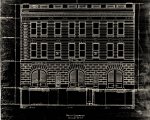
The three-story building at the Chambers Street and Centre Street corner of City Hall Park, constructed in 1851, had three apparatus bays to house three different fire companies: Engine Company No. 22 (predecessor to Engine Company No. 7), Hose Company No. 28, and Hook & Ladder Company No. 1. But the width of this building was an exception; most firehouses were built on narrow city lots and had but a single bay, the ground story of which was, for the most part, a doorway wide and high enough to accommodate engines, hose, and hook and ladder wagons. Only after 1853 and the publication of Marriott Field's City Architecture was a general effort made to architecturally differentiate the firehouse from the conventional urban stable building type. The city's Fire Department contracted from 1880 to 1895 with the firm of Napoleon LeBrun & Son to design firehouses.
This firm's straightforward designs and use of materials -- brick, stone, iron and sparely integrated terra-cotta ornament -- upgraded the basic stable elevation with a sense of sober purpose consistent with the disciplined companies of professional firefighters who resided within them. The LeBruns' last firehouse commission in 1895 was their grandest, a tall-roofed, French Renaissance-inspired battalion headquarters (Engine Company No. 31, a designated New York City Landmark) on the corner of White and Lafayette Streets. With the return of the Tammany organization to power, the department began to award commissions to a number of firms. The coincidence of the consolidation of greater New York in 1898 and the City Beautiful Movement prompted the Fire Commissioners to favor designs redolent of municipal authority. Firehouse elevations, although comprised of a single apparatus bay on the ground story and generally two residential stories above, assumed a more elaborate character.
Hoppin & Koen's Fire Engine Company No. 65 (1897-98, a designated New York City Landmark) at 33 West 43rd Street, the Beaux-Arts facade of Ernest Flagg's Engine Company 33 (1898-99, a designated New York City Landmark) at 44 Great Jones Street, and Horgan & Slattery's Engine Company No. 6 (1902-03) on Beekman Street are all good examples. But the greater width of the facade of Trowbridge & Livingston's new firehouse at 100-104 Duane Street, a departure from conventional firehouse design, was dictated by function; not only was each of the apparatus bays wide and high enough to accommodate a Clapp & Jones steam engine, but the three-bay facade reflected the necessity for one engine company to maintain two steam engines at the ready in a neighborhood of tall buildings.
Trowbridge & Livingston
Samuel Breck Parkman Trowbridge Goodhue Livingston
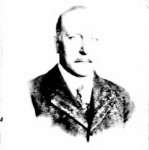

Trowbridge, Colt & Livingston, a partnership of three graduates of the architecture Program within Columbia's School of Mines – Samuel Breck Parkman Trowbridge (1862-1925), Stockton B. Colt (1863-1937), and Goodhue Livingston (1865-1951) -- was formed in 1894. Colt withdrew five years later to start his own practice; the Trowbridge & Livingston firm continued until 1946. S.B.P. Trowbridge, born in New York City, received his early education in the New York public schools. Trowbridge's father, William P. Trowbridge, had been an U.S. Army engineer, supervising the construction of the Fort Totten Battery, repairs to Fort Schuyler, and work at Governor's Island (all designated New York City Landmarks), and subsequently taught engineering at Yale and then at Columbia. The younger Trowbridge graduated from Trinity College in Hartford, Connecticut, in 1883 and Columbia in 1886, continuing at the American School of Classical Studies in Athens (he supervised the erection of the School's building) and at the Ecole des Beaux-Arts in the Atelier Daumet-Grault. On his return to New York, Trowbridge entered George B. Post's office in 1890. Goodhue Livingston, a descendant of a prominent colonial New York family, received his undergraduate and graduate degrees from Columbia. Following graduation, Livingston went to work in George B. Post's office also.
By the time that Trowbridge & Livingston received the commission for the Engine Company No. 7/Ladder Company No. I firehouse in 1904, the firm's work already included a number of distinctive city and country residences, the St. Regis Hotel (1901-04, a designated New York City Landmark), and the Adelbert S. Hay Memorial Chapel (1902-03) at the Westminster School in Simsbury, Connecticut. Subsequent commissions, the Chemical National Bank Building (1905-07) at 270 Broadway (demolished), the B. Altman Department Store Building (1905-1914, a designated New York City Landmark) at Fifth Avenue and 34th Street, the Massachusetts Mutual Life Insurance Company Building (1907-08) in Springfield, Massachusetts, the Palace Hotel (1909-10) in San Francisco, the J.P. Morgan and Company Building (1913-15, a designated New York City Landmark) at 23 Wall Street, the American Red Cross National Headquarters (begun in 1915, with subsequent additions by the firm until 1931) in Washington, D.C., the John S. Rogers House (1916-17, now the New York Society Library and a designated New York City Landmark) at 53 East 79th Street, additions to the New York Stock Exchange (1920-22) at 9-13 Wall Street, the wings (1923-24) flanking the American Museum of Natural History's central pavilion (John Russell Pope's Theodore Roosevelt National Memorial) on Central Park West (the whole is a designated New York City Landmark), and the National Bank of North America Building (1925-26) at 44 Wall Street suggest the range of building types undertaken by the firm as well as the breadth of the firm's reputation within Trowbridge's lifetime.
Trowbridge & Livingston designed in what at the time was described as the "modern French" style employed by many of the American architects who trained at the Ecole des Beaux-Arts and practiced in the first three decades of this century. The firm’s restrained and academic use of the classical architectural vocabulary contributed great dignity to the variety of building types, from residences to skyscrapers, that it was called upon to execute. Nor did the firm's reputation for fine craftsmanship and restrained elegance diminish after Trowbridge's death, although subsequent commissions demonstrated the influence of more contemporary European design, like the Art Deco Hayden Planetarium (1935) at the American Museum of Natural History. Both the Upper East Side Historic District and the Upper West Side/Central Park West Historic District include buildings designed by Trowbridge & Livingston. Trowbridge became an Associate of the American Institute of Architects in 1901 and was elected a Fellow in 1906; Livingston became an Associate in 1902 and was elected a Fellow in 1908. Trowbridge was an incorporator and trustee of the American Academy in Rome, a Chevalier of the Legion of Honor, and served as President of both the National Academy of Design and the Architectural League of New York.
Design of the Engine Company No. 7 and Hook & Ladder No. 1 Firehouse
In the architectural program for this fire station commission, Trowbridge & Livingston was called upon to house two separate companies, Engine Company No. 7 with its two steamers, hose tenders, horses, and a complement of twenty five members, and Hook & Ladder Company No. 1 with its ladder wagon, horses, and seventeen members. In plan, the eastern two-thirds of the seventy-five foot site was assigned to Engine Company No. 7; the remaining third to Hook & Ladder No. I. Two apparatus doorways, with a personnel entrance between them, open to Duane Street from the ground story of the Engine Company No. 7 side; in the original drawing for this elevation, earred tablets above the voussoirs of each of these two apparatus doorways carry the following: "7 ENGINE 7" (Plate 1). On Hook & Ladder Company No. l 's side there is one apparatus doorway and to its left, one personnel entrance; inscribed within the earred tablet over the apparatus doorway in the original drawing is: "I HOOK & LADDER I." A fire wall, rising from the basement through three stories to the roof, still separates these two distinct spaces, each with its own furnace, stairways, fire poles, kitchen, officers' quarters, dormitory and bathrooms.
In the Duane Street facade the off-center, vertical division of these two units is masked behind a symmetrical, three-story elevation of great strength and remarkable unity. In the building's smooth-faced rusticated ashlar limestone first-story base, three three-centered arched, apparatus doorways, the center doorway flanked by lower flat-headed personnel entrances, establish the symmetrical rhythm of wide and narrow bays apparent in the paired and single fenestration of the upper stories, the triple, paired and single roundels in the entablature frieze, and the paired and single panels in the parapet above. The emphatic horizontality of the alternating bands of brick and raised, smooth-faced, limestone ashlar, which articulate the upper two stories and incorporate the attenuated keystones and voussoirs of the flat-arched second-story windows, diffuses the vertical rhythm of wide and narrow bays and contributes to the unity of the design. The entasis (the slight tilt inward) at the extreme ends of the second and third story banding, seen best in the blueprint (Plate 1), defines this original scheme. The details in this facade, the symmetry of the alternating bays, the attenuated keystones and elbow voussoirs, and the sophisticated precision of the brick and limestone banding, suggest the architecture of early seventeenth-century France, as seen in the modernization of Paris during the reign of Henri IV and the work of architects Jean Metezeau, Salomon de Brosse and Frarn;ois Mansart. Metezeau, de Brosse and Mansart were all aware of an Italian Renaissance prototype, the urban palace facade. This sophisticated adaptation of the seventeenth-century style is characteristic of the work of those trained at the Ecole des BeauxArts in the late nineteenth century and, as rendered in this firehouse facade, is a successful example of work in the "modern French" style (today identified as the Beaux-Arts style, after the source of its practioners' training). The care and authority with which this municipal service building facade is endowed and the historic reference to urban improvement in its design can be seen as a conscious contribution toward the burgeoning City Beautiful Movement.
BUILDING DESCRIPTION
This three-story firehouse is constructed of limestone and gray brick above a granite base . Three, three-centered arched, apparatus doorways -- the center doorway flanked by lower, flat-headed personnel entrances -- order the rusticated and smooth-faced limestone ashlar surface of the building's ground story. Granite spur stones, painted yellow, flank each of these apparatus doorways and thick steel-plate sheathing protects the full intrados of each of these arched doorways. Protected utility lights project within each of the left and center arches. Each apparatus doorway has a wood- and glass-paneled overhead door. The personnel door on the left is of wood and has a lozenge-shaped glass window, the personnel entrance door on the right is covered with sheet metal. A bronze, commemorative plaque, fixed to the rusticated limestone between this door and the left-hand apparatus doorway, is dedicated to the members of both companies who gave their lives in the line of duty. Above each apparatus doorway, earred tablets, raised from the heavy belt course capping the rusticated ground story, identify the occupant within: "7 Engine 7" in bronze numbers and letters appears on the tablet over the left-hand apparatus doorway and "1 Hook & Ladder 1" appears on the tablet over the center apparatus door. There is a bronze plaque above the center tablet.
The second and third stories are faced with a distinctive treatment of gray brick and limestone banding. Each brick band is comprised of four courses laid in stretcher bond. The flat-arch second-story window lintels incorporate both the brick and limestone bands as elbow voussoirs, or crosettes; the voussoir bricks are a remarkable example of cut and gauged brick. All of the windows on both the second and third stories contain four-over-four wood sash windows, except the second-story window, third from the left. This window is divided by a wood mullion, forming two narrow one-over-one sash windows. A flagpole projects out from a tri-faceted support fixed below and accessible from this window. Both this double window and the second-story window, third from the right, are still glazed with Florentine glass. The third-story window sills are supported by guttae. The entablature frieze is articulated with a series of roundels, triple at the extreme ends and alternately double and single in between, echoing the wide and narrow rhythm of the facade below. Above the modillioned entablature cornice, the paneled parapet repeats this alternating rhythm. The rectangular panels, enframed in gray brick, are diamond-cut.
SUBSEQUENT HISTORY
Originally, the apparatus doors were steel, hinged at their sides and lit with prism lights. The personnel entrance doors were kalamein and had prism lights (Plate 1). The flagpole, rising from behind the parapet, was centered above the facade (Plate 1). Soon after the Fire Department became motorized in 1910, Engine Company No. 7 required neither two fire engines nor two bays. Hook & Ladder Company No. 1 moved from the separate bay to the west into the now-vacant center bay. The bronze numbering and lettering on the overdoor tablets was changed to signify this move.
NOTES
The western bay, c. 1920, became the Fire Department Museum and remained as such until 1987 when the collection of antique engines, buggies, harness and other departmental memorabilia was moved to 278 Spring Street (Manhattan). Today, this separate unit houses the Fire Department's Bureau of Fire Communications. The utility lights within the arched doorways, though not original, warn passersby and motorists that the apparatus is about to roll. Except for these few alterations, the Engine Company No. 7/Hook & Ladder Company No. 1 firehouse facade has changed very little since these two companies relocated to this their new building in 1905.
Report prepared by Charles Savage,
Research Department
LANDMARK REPORT
100 DUANE STREET ENGINE COMPANY NO. 7/HOOK & LADDER COMPANY NO. 1 FIREHOUSE - DESIGN/HISTORY

100-104 Duane Street, Borough of Manhattan.
Built 1904-05; architects Trowbridge & Livingston.
Landmark Site: Borough of Manhattan Tax Map Block 150, Lot 25.
On September 19, 1989, the Landmarks Preservation Commission held a public hearing on the proposed designation as Landmark of the Engine Company 7 /Ladder Company 1 Fire House, and the proposed designation of the related Landmark Site (Item No. 5). The hearing had been duly advertised in accordance with the provisions of law. Two witnesses testified in favor of the designation; four letters were received in support of the designation. No one spoke against the proposed designation.
DESCRIPTION AND ANALYSIS
Summary
The Engine Company No. 7/Hook & Ladder Company No. 1 Firehouse, designed in the Beaux-Arts style -- or what at the time was described as the "modem French" style -- by the prominent architectural firm of Trowbridge & Livingston and built in 1904-05, is a building of great architectural quality. The three-story firehouse's three-bay width was dictated by the two-bay requirement of an enlarged engine company and a third bay for a separate hook & ladder company. The architects created a facade remarkable for its symmetry and emphatic horizontality. It is visually unified by superimposed architectural elements drawn from early seventeenth-century French civic architecture: the boldly rusticated Indiana limestone ground story, the brick and raised limestone bands of the upper stories, the entablature and parapet. The seventeenth-century French architects adapted these elements from the urban palace facades of the Italian Renaissance.
In the often heroic execution of their mandated responsibilities, Engine Company No. 7 and Hook & Ladder Company No. 1, two of the city's oldest fire companies, share an honored place in the city's history. The companies, housed together since 1851, were sited in the northeast comer of City Hall Park. The new Duane Street location was chosen both for its proximity to the center of municipal government and to assure protection for the new skyscrapers going up adjacent to the park. This dynamic firehouse facade projects the strength and solidity associated with an arm of municipal government and is appropriate to the home of those dedicated to protecting the lives and property of the citizens of New York.
City Hall Park and its Neighborhood
In the seventeenth century the area that is now City Hall Park was part of the common fields north of the colonial settlement of New Amsterdam and then New York. By the end of the nineteenth century the park itself had become the location of numerous public buildings of varying architectural distinction housing a variety of municipal functions, from Mangin and Macomb's City Hall to the two firehouses on Chambers Street. To check this congestion and regain a semblance of park, a proposal was put forward to remove the buildings at the park's north end. The final scheme of 1895 called only for the retention of City Hall and the Tweed Court House. The functions of municipal government to be removed from the park were housed in new structures built across from or nearby the park: the Surrogate's Court/Hall of Records Building (1897-1906, a designated New York City Landmark), designed by John R. Thomas for the block on the north side of Chambers, west of Centre Street; the Municipal Building (1909-14, a designated New York City Landmark), designed by McKim, Mead & White to bridge Chambers Street east of Centre; and the firehouse (1904-05) at 100-104 Duane Street, designed by Trowbridge & Livingston for Engine Company No. 7 and Hook & Ladder Company No. 1, both formerly located in the northeast corner of City Hall Park.
Meanwhile, tall commercial buildings and skyscrapers were going up around City Hall Park. The earliest were those on that section of Park Row known as Printing House Square, on the park's east side (where Pace University now stands). The first tall buildings west of City Hall Park were the Postal Telegraph and Home Life Insurance Company Buildings (1892-94, a designated New York Landmark), fronting on Broadway between Murray and Warren Streets. In the same year the Mutual Reserve (also called the Langdon) Building, designed by William H. Hume & Son in 1894, opened on the northwest corner of Duane Street and Broadway. It was soon followed by several distinguished towers: the Dun Building (Harding & Gooch, 1898, now demolished) on the northeast corner of Broadway and Reade Street; Cass Gilbert's Broadway-Chambers Building (1899-1900, a designated New York City Landmark); and the Ungar/Barclay Building (Stockton B. Colt, 1902-05) on the southwest corner of Broadway and Duane Street. Certainly this new density of tall commercial structures, rising next to the older five-story buildings, required the presence of a Fire Department facility. The Duane Street location for this new, up-to-date firehouse was both close enough to still serve the civic center and was immediately adjacent to the new concentration of tall buildings just northwest of City Hall Park. The wide lot on the south side of Duane Street was purchased by the City on February 11, 1904.
HISTORY
Engine Company No. 7 and Hook & Ladder Co. No. 1
Hook & Ladder Company No. 1, one of the oldest in the Fire Department and the only company to retain the same numeral through the transition from a volunteer to a paid professional department in 1865, was in existence before the American Revolution; its members, along with the rest of the volunteer fire department, marched off to join the Continental Army. In 1786 the returning veterans and the interim volunteers were reorganized by the city's new Mayor, James Duane. Several years later Hook & Ladder Company No. 1 styled itself "Mutual" Hook & Ladder No. 1. Throughout its long history, both before and after the professional department was introduced, Hook & Ladder Company No. 1 has been housed in close proximity to the seat of municipal government. The company hung its hooks and ladders in the main ground story passageway of the predecessor City Hall (old Federal Hall) on Wall Street (the site of the Federal Hall National Memorial). The company was moved to the Bridewell in 1813 and subsequently to Whitehall Street. In 1830 it was at 24 Beaver Street where it remained until 1842 when it was moved to the basement of the old Dispensary at 26 Chambers Street in City Hall Park.
Engine Company No. 7, before 1865, was "Protector" Engine Company No. 22 in the volunteer department. 8 In 1840 this company was formed to run a large engine, "Old Junk," and was housed at Chambers and Centre Streets in City Hall Park -- perhaps in the basement of the old Dispensary also.9 On July 14, 1851, the Common Council appropriated money to construct a three-story building in City Hall Park to house two companies (subsequently Hose Company No. 28 was absorbed into Engine Company No. 7) under one roof for the first time: "Protector" Engine Company No. 22, then at 22 Chambers Street; and "Mutual" Hook & Ladder Company No. 1, then at 26 Chambers Street.
Both companies have played an important part in New York's history. John W. Towt, a leather merchant by trade as well as "Mutual" Hook & Ladder Company No. 1's foreman c.1828, made firemen's hats, devising a unique and functional design with a high, rounded crown and long rear brim. Towt purchased the first horse ever owned by the Fire Department; the horse pulled the hook and ladder wagon to fires in the neighborhoods most severely affected during the cholera epidemic of 1832, where many volunteers, who usually ran with the apparatus, feared to go. "Mutual" Hook & Ladder Company No. 1 participated in many civic ceremonies: in the firemen's display in Lafayette's honor in 1824 in front of City Hall; the funeral processions of Presidents John Quincy Adams and Andrew Jackson; and the official opening of the Croton Aqueduct on October 14, 1842. In December 1853 the crowd assembled in Franklin Square cheered as company members handed the young female employees down the ladders from the blazing Harper Brothers' paper warehouse.
But heroic deeds were often shaded with calamity. Many firemen perished in May of the following year when the walls of the burning W. T. Jennings' & Co. building at 231 Broadway collapsed. Although "Protector" Engine Company No. 22's district was different from Hook & Ladder No. 7's, there is no doubt that this company participated in putting out these and other fires in lower Manhattan. "Protector" Engine Company No. 22 was one of companies that commandeered the ferry to Brooklyn to extinguish the great blaze at 21 Fulton Street in 1842.
After the volunteer department was abolished in 1865, Hook & Ladder Company No. 1 and Engine Company No. 7 continued to be neighbors at 26 and 22 Chambers Street respectively. Entries in Engine Company No. 7's daily Journals indicate that telegraph messages from headquarters were received at Hook & Ladder Company No. 1 and brought over by a company member; likewise, messages from Engine Company No. 7 were taken over to 26 Chambers Street to be sent out.
Officers from either firehouse were often ordered to relieve one another in any temporary absence. The new professional department adopted a para-military regime; the firemen on duty resided at the firehouse. Horses had replaced the running firemen when the new heavier steam engines and longer, heavier ladders were introduced: the horses had to be fed, exercised and shod; and the boilers of the steam engines – a Clapp & Jones Steam Fire Engine, in the case of Engine Company No. 7 -- had to be maintained at a constant twenty pounds pressure. But this routine of readiness was often interrupted when the gong sounded and the apparatus rolled. At the end of the nineteenth century the greatest challenge facing the Fire Department was how to extinguish fires in tall buildings like those being erected adjacent to City Hall Park. On December 4, 1898, a spectacular, ten-alarm fire broke out in the five-story Rogers Peet clothing store at Warren Street and Broadway and, fanned by a stormy east wind, spread to the upper stories of the sixteen story Home Life Insurance Company Building next door and beyond to the top of the Postal Telegraph Building at Broadway and Murray Street. Both Hook & Ladder Company No. 1 and Fire Engine Company No. 7 fought the fire.
Front page material for a week and still news in the ensuing months, this fire raised two controversial issues: the effectiveness of fireproof construction in tall buildings; as well as the ability of the Fire Department to put out fires in tall buildings. Edward F. Croker, the Chief of the Fire Department, advocated building-height limitations for some time after the Rogers Peet and Home Life Insurance Company Building fire. A single steam fire-engine was unable to throw water effectively above the eighth story. Greater thrust could only be achieved when two or more engines were linked. For areas of the city where tall buildings were becoming the predominant building type, as they were around City Hall Park, there was concern that more apparatus would be needed, especially fire engines. By 1904 Chief Croker had begun to double steam engines in fire companies where previously one engine had sufficed. When, a year later, Engine Company No. 7 and Hook & Ladder Company No. 1 relocated to their new firehouse on Duane Street, they moved into a building that had been designed with three apparatus bays, one for the Hook & Ladder wagon and two for two steam engines and accompanying hose wagons.
GENERAL FIREHOUSE DESIGN

The three-story building at the Chambers Street and Centre Street corner of City Hall Park, constructed in 1851, had three apparatus bays to house three different fire companies: Engine Company No. 22 (predecessor to Engine Company No. 7), Hose Company No. 28, and Hook & Ladder Company No. 1. But the width of this building was an exception; most firehouses were built on narrow city lots and had but a single bay, the ground story of which was, for the most part, a doorway wide and high enough to accommodate engines, hose, and hook and ladder wagons. Only after 1853 and the publication of Marriott Field's City Architecture was a general effort made to architecturally differentiate the firehouse from the conventional urban stable building type. The city's Fire Department contracted from 1880 to 1895 with the firm of Napoleon LeBrun & Son to design firehouses.
This firm's straightforward designs and use of materials -- brick, stone, iron and sparely integrated terra-cotta ornament -- upgraded the basic stable elevation with a sense of sober purpose consistent with the disciplined companies of professional firefighters who resided within them. The LeBruns' last firehouse commission in 1895 was their grandest, a tall-roofed, French Renaissance-inspired battalion headquarters (Engine Company No. 31, a designated New York City Landmark) on the corner of White and Lafayette Streets. With the return of the Tammany organization to power, the department began to award commissions to a number of firms. The coincidence of the consolidation of greater New York in 1898 and the City Beautiful Movement prompted the Fire Commissioners to favor designs redolent of municipal authority. Firehouse elevations, although comprised of a single apparatus bay on the ground story and generally two residential stories above, assumed a more elaborate character.
Hoppin & Koen's Fire Engine Company No. 65 (1897-98, a designated New York City Landmark) at 33 West 43rd Street, the Beaux-Arts facade of Ernest Flagg's Engine Company 33 (1898-99, a designated New York City Landmark) at 44 Great Jones Street, and Horgan & Slattery's Engine Company No. 6 (1902-03) on Beekman Street are all good examples. But the greater width of the facade of Trowbridge & Livingston's new firehouse at 100-104 Duane Street, a departure from conventional firehouse design, was dictated by function; not only was each of the apparatus bays wide and high enough to accommodate a Clapp & Jones steam engine, but the three-bay facade reflected the necessity for one engine company to maintain two steam engines at the ready in a neighborhood of tall buildings.
Trowbridge & Livingston
Samuel Breck Parkman Trowbridge Goodhue Livingston


Trowbridge, Colt & Livingston, a partnership of three graduates of the architecture Program within Columbia's School of Mines – Samuel Breck Parkman Trowbridge (1862-1925), Stockton B. Colt (1863-1937), and Goodhue Livingston (1865-1951) -- was formed in 1894. Colt withdrew five years later to start his own practice; the Trowbridge & Livingston firm continued until 1946. S.B.P. Trowbridge, born in New York City, received his early education in the New York public schools. Trowbridge's father, William P. Trowbridge, had been an U.S. Army engineer, supervising the construction of the Fort Totten Battery, repairs to Fort Schuyler, and work at Governor's Island (all designated New York City Landmarks), and subsequently taught engineering at Yale and then at Columbia. The younger Trowbridge graduated from Trinity College in Hartford, Connecticut, in 1883 and Columbia in 1886, continuing at the American School of Classical Studies in Athens (he supervised the erection of the School's building) and at the Ecole des Beaux-Arts in the Atelier Daumet-Grault. On his return to New York, Trowbridge entered George B. Post's office in 1890. Goodhue Livingston, a descendant of a prominent colonial New York family, received his undergraduate and graduate degrees from Columbia. Following graduation, Livingston went to work in George B. Post's office also.
By the time that Trowbridge & Livingston received the commission for the Engine Company No. 7/Ladder Company No. I firehouse in 1904, the firm's work already included a number of distinctive city and country residences, the St. Regis Hotel (1901-04, a designated New York City Landmark), and the Adelbert S. Hay Memorial Chapel (1902-03) at the Westminster School in Simsbury, Connecticut. Subsequent commissions, the Chemical National Bank Building (1905-07) at 270 Broadway (demolished), the B. Altman Department Store Building (1905-1914, a designated New York City Landmark) at Fifth Avenue and 34th Street, the Massachusetts Mutual Life Insurance Company Building (1907-08) in Springfield, Massachusetts, the Palace Hotel (1909-10) in San Francisco, the J.P. Morgan and Company Building (1913-15, a designated New York City Landmark) at 23 Wall Street, the American Red Cross National Headquarters (begun in 1915, with subsequent additions by the firm until 1931) in Washington, D.C., the John S. Rogers House (1916-17, now the New York Society Library and a designated New York City Landmark) at 53 East 79th Street, additions to the New York Stock Exchange (1920-22) at 9-13 Wall Street, the wings (1923-24) flanking the American Museum of Natural History's central pavilion (John Russell Pope's Theodore Roosevelt National Memorial) on Central Park West (the whole is a designated New York City Landmark), and the National Bank of North America Building (1925-26) at 44 Wall Street suggest the range of building types undertaken by the firm as well as the breadth of the firm's reputation within Trowbridge's lifetime.
Trowbridge & Livingston designed in what at the time was described as the "modern French" style employed by many of the American architects who trained at the Ecole des Beaux-Arts and practiced in the first three decades of this century. The firm’s restrained and academic use of the classical architectural vocabulary contributed great dignity to the variety of building types, from residences to skyscrapers, that it was called upon to execute. Nor did the firm's reputation for fine craftsmanship and restrained elegance diminish after Trowbridge's death, although subsequent commissions demonstrated the influence of more contemporary European design, like the Art Deco Hayden Planetarium (1935) at the American Museum of Natural History. Both the Upper East Side Historic District and the Upper West Side/Central Park West Historic District include buildings designed by Trowbridge & Livingston. Trowbridge became an Associate of the American Institute of Architects in 1901 and was elected a Fellow in 1906; Livingston became an Associate in 1902 and was elected a Fellow in 1908. Trowbridge was an incorporator and trustee of the American Academy in Rome, a Chevalier of the Legion of Honor, and served as President of both the National Academy of Design and the Architectural League of New York.
Design of the Engine Company No. 7 and Hook & Ladder No. 1 Firehouse
In the architectural program for this fire station commission, Trowbridge & Livingston was called upon to house two separate companies, Engine Company No. 7 with its two steamers, hose tenders, horses, and a complement of twenty five members, and Hook & Ladder Company No. 1 with its ladder wagon, horses, and seventeen members. In plan, the eastern two-thirds of the seventy-five foot site was assigned to Engine Company No. 7; the remaining third to Hook & Ladder No. I. Two apparatus doorways, with a personnel entrance between them, open to Duane Street from the ground story of the Engine Company No. 7 side; in the original drawing for this elevation, earred tablets above the voussoirs of each of these two apparatus doorways carry the following: "7 ENGINE 7" (Plate 1). On Hook & Ladder Company No. l 's side there is one apparatus doorway and to its left, one personnel entrance; inscribed within the earred tablet over the apparatus doorway in the original drawing is: "I HOOK & LADDER I." A fire wall, rising from the basement through three stories to the roof, still separates these two distinct spaces, each with its own furnace, stairways, fire poles, kitchen, officers' quarters, dormitory and bathrooms.
In the Duane Street facade the off-center, vertical division of these two units is masked behind a symmetrical, three-story elevation of great strength and remarkable unity. In the building's smooth-faced rusticated ashlar limestone first-story base, three three-centered arched, apparatus doorways, the center doorway flanked by lower flat-headed personnel entrances, establish the symmetrical rhythm of wide and narrow bays apparent in the paired and single fenestration of the upper stories, the triple, paired and single roundels in the entablature frieze, and the paired and single panels in the parapet above. The emphatic horizontality of the alternating bands of brick and raised, smooth-faced, limestone ashlar, which articulate the upper two stories and incorporate the attenuated keystones and voussoirs of the flat-arched second-story windows, diffuses the vertical rhythm of wide and narrow bays and contributes to the unity of the design. The entasis (the slight tilt inward) at the extreme ends of the second and third story banding, seen best in the blueprint (Plate 1), defines this original scheme. The details in this facade, the symmetry of the alternating bays, the attenuated keystones and elbow voussoirs, and the sophisticated precision of the brick and limestone banding, suggest the architecture of early seventeenth-century France, as seen in the modernization of Paris during the reign of Henri IV and the work of architects Jean Metezeau, Salomon de Brosse and Frarn;ois Mansart. Metezeau, de Brosse and Mansart were all aware of an Italian Renaissance prototype, the urban palace facade. This sophisticated adaptation of the seventeenth-century style is characteristic of the work of those trained at the Ecole des BeauxArts in the late nineteenth century and, as rendered in this firehouse facade, is a successful example of work in the "modern French" style (today identified as the Beaux-Arts style, after the source of its practioners' training). The care and authority with which this municipal service building facade is endowed and the historic reference to urban improvement in its design can be seen as a conscious contribution toward the burgeoning City Beautiful Movement.
BUILDING DESCRIPTION
This three-story firehouse is constructed of limestone and gray brick above a granite base . Three, three-centered arched, apparatus doorways -- the center doorway flanked by lower, flat-headed personnel entrances -- order the rusticated and smooth-faced limestone ashlar surface of the building's ground story. Granite spur stones, painted yellow, flank each of these apparatus doorways and thick steel-plate sheathing protects the full intrados of each of these arched doorways. Protected utility lights project within each of the left and center arches. Each apparatus doorway has a wood- and glass-paneled overhead door. The personnel door on the left is of wood and has a lozenge-shaped glass window, the personnel entrance door on the right is covered with sheet metal. A bronze, commemorative plaque, fixed to the rusticated limestone between this door and the left-hand apparatus doorway, is dedicated to the members of both companies who gave their lives in the line of duty. Above each apparatus doorway, earred tablets, raised from the heavy belt course capping the rusticated ground story, identify the occupant within: "7 Engine 7" in bronze numbers and letters appears on the tablet over the left-hand apparatus doorway and "1 Hook & Ladder 1" appears on the tablet over the center apparatus door. There is a bronze plaque above the center tablet.
The second and third stories are faced with a distinctive treatment of gray brick and limestone banding. Each brick band is comprised of four courses laid in stretcher bond. The flat-arch second-story window lintels incorporate both the brick and limestone bands as elbow voussoirs, or crosettes; the voussoir bricks are a remarkable example of cut and gauged brick. All of the windows on both the second and third stories contain four-over-four wood sash windows, except the second-story window, third from the left. This window is divided by a wood mullion, forming two narrow one-over-one sash windows. A flagpole projects out from a tri-faceted support fixed below and accessible from this window. Both this double window and the second-story window, third from the right, are still glazed with Florentine glass. The third-story window sills are supported by guttae. The entablature frieze is articulated with a series of roundels, triple at the extreme ends and alternately double and single in between, echoing the wide and narrow rhythm of the facade below. Above the modillioned entablature cornice, the paneled parapet repeats this alternating rhythm. The rectangular panels, enframed in gray brick, are diamond-cut.
SUBSEQUENT HISTORY
Originally, the apparatus doors were steel, hinged at their sides and lit with prism lights. The personnel entrance doors were kalamein and had prism lights (Plate 1). The flagpole, rising from behind the parapet, was centered above the facade (Plate 1). Soon after the Fire Department became motorized in 1910, Engine Company No. 7 required neither two fire engines nor two bays. Hook & Ladder Company No. 1 moved from the separate bay to the west into the now-vacant center bay. The bronze numbering and lettering on the overdoor tablets was changed to signify this move.
NOTES
The western bay, c. 1920, became the Fire Department Museum and remained as such until 1987 when the collection of antique engines, buggies, harness and other departmental memorabilia was moved to 278 Spring Street (Manhattan). Today, this separate unit houses the Fire Department's Bureau of Fire Communications. The utility lights within the arched doorways, though not original, warn passersby and motorists that the apparatus is about to roll. Except for these few alterations, the Engine Company No. 7/Hook & Ladder Company No. 1 firehouse facade has changed very little since these two companies relocated to this their new building in 1905.
Report prepared by Charles Savage,
Research Department
LANDMARK REPORT
Last edited:
Engine 7/Ladder 1/Battalion 1 (continued)
100 DUANE STREET FIREHOUSE
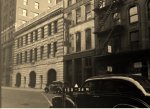
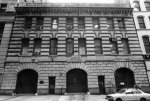
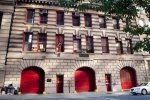
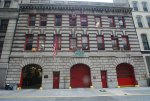

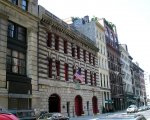
FDNY - Battalion 1 / Engine 7 / Ladder 1 (New York City, New York)
3-story Beaux-Arts fire station completed in 1905. Designed by Trowbridge & Livingston as Engine Company No. 7/Hook & Ladder Company No. 1. It is clad in boldly rusticated Indiana limestone on the ground floor, with alternating grey-brown brick and raised limestone bands on the upper floors. The ground floor is dominated by three large red-painted garage doors; the window frames of the upper floors are also painted bright red. Above the modillioned cornice is a paneled stone parapet.
The fire house was built to house two separate companies: Engine Company No. 7 with its two steamers, hose tenders, horses, and a complement of 25 members; and Hook & Ladder No. 1 with its ladder wagon, horses, and 17 members. In 1920, the western arch-bay became the Fire Department Museum, and remained as such until 1987 when the memorabilia was moved to 278 Spring Street. Today this separate unit houses the fire department's Bureau of Fire Communications.
The building continues to serve the NYFD, housing Division 1 : Battalion 1 (HQ) and home to the FDNY Office of the Manhattan Borough Chief. It was featured in the documentary film "9|11".
http://wikimapia.org/15927810/FDNY-Battalion-1-Engine-7-Ladder-1
100 DUANE STREET FIREHOUSE






FDNY - Battalion 1 / Engine 7 / Ladder 1 (New York City, New York)
3-story Beaux-Arts fire station completed in 1905. Designed by Trowbridge & Livingston as Engine Company No. 7/Hook & Ladder Company No. 1. It is clad in boldly rusticated Indiana limestone on the ground floor, with alternating grey-brown brick and raised limestone bands on the upper floors. The ground floor is dominated by three large red-painted garage doors; the window frames of the upper floors are also painted bright red. Above the modillioned cornice is a paneled stone parapet.
The fire house was built to house two separate companies: Engine Company No. 7 with its two steamers, hose tenders, horses, and a complement of 25 members; and Hook & Ladder No. 1 with its ladder wagon, horses, and 17 members. In 1920, the western arch-bay became the Fire Department Museum, and remained as such until 1987 when the memorabilia was moved to 278 Spring Street. Today this separate unit houses the fire department's Bureau of Fire Communications.
The building continues to serve the NYFD, housing Division 1 : Battalion 1 (HQ) and home to the FDNY Office of the Manhattan Borough Chief. It was featured in the documentary film "9|11".
http://wikimapia.org/15927810/FDNY-Battalion-1-Engine-7-Ladder-1
Last edited:
Engine 7/Ladder 1/Battalion 1 (continued)
100 DUANE STREET FIREHOUSE - HISTORY

Hook & Ladder 1 / Engine Company 7 -- No. 100 Duane Street

By the turn of the last century Hook & Ladder Company No. 1 and Engine Company No. 7 had had an unusually close relationship for decades. The separate companies had been located nearby one another since the organization of the professional fire department in 1865 when they were housed steps away at Nos. 22 and 26 Chambers Street. Hook & Ladder No. 1, for instance, had a telegraph receiver at No. 22, while Engine Company No. 7 did not. Messages were run back and forth by fire fighters between the two companies to solve the problem.
But the histories of the companies went much further back. Hook & Ladder Company No. 1 was established during British rule, on July 10, 1772. After many of its volunteer members marched off to fight in the Revolution, it was reorganized in 1784 and given the name “Mutual Hook & Ladder No. 1.” It was Mutual Hook & Ladder No. 1’s foreman who designed the fireman’s helmet with the high crown and broad rear brim in the late 1820s. It is still used today with some variations.
Around 1830, not long after John W. Towt designed the helmet, the Protector Engine Company No. 22 was formed. Firefighting at the time relied on a disorganized collection of volunteer companies manned by neighborhood men called “laddies.” Many of the companies earned a reputation as rowdy, boisterous groups; and nearby fire houses would compete with one another to arrive at a fire first, or to become the more skilled at extinguishing it.
The devastating fire that destroyed Barnum’s Museum in 1865 along with pressure on the State Assembly by reformers resulted in the Act of 1865 that coupled Brooklyn and New York with a paid, united “Metropolitan District” fire department. Hook & Ladder No. 1 was unique among all the city’s companies. It not only was allowed to keep its name and number; but according to firefighter and department historian Paul Porcello, it “continued with the same truck, same helmets, same location, and nine of the new twelve members had served in the old volunteer company.”
Protector Engine Company No. 22 was reorganized as the professional Engine Company No. 7 and was installed at No. 26 Chambers Street close to Hook & Ladder No. 1. The companies would be relocated several times; always remaining together or close by.
As the turn of the century neared, a new challenge faced the Fire Department—the ever-growing height of downtown buildings. The steam pumper engines could shoot water no higher than a few stories; a problem that was made clear on December 4, 1898. Engine Company No. 7 and Hook & Ladder No. 1 both responded to a massive blaze in the five-story Rogers Peet menswear store at Broadway and Warren Street. The devastating fire sparked serious discussion about the how to more successfully battle high-rise fires. Among Chief Edward F. Croker’s solutions was to double-up the apparatus of engine companies. By adding a second truck the linked engines could achieve more thrust. His plan was initiated in 1904.
To accommodate its second engine, a new fire house was necessary for Engine Company No. 7. Three lots were acquired at Nos. 100 through 104 Duane Street and the old commercial buildings demolished.
From 1879 to 1895 Napoleon LeBrun & Sons had the enviable position as official architects to the New York City Fire Department and created sometimes opulent fire houses throughout the city. Now the Tammany Hall awarded commissions to various architectural firms. The esteemed firm of Trowbridge & Livingston was commissioned to design the new joint station of Engine Company 7 and Hook & Ladder Company No. 1.
Construction was completed a year later and the companies moved in on New Year’s Eve 1905. Trowbridge & Livingston had produced an especially handsome French Renaissance structure of red brick with heavy stone banding above a rusticated limestone base. The 75-foot wide structure featured three bay doors—two for Engine Company 7’s apparatus; and the other for Hook & Ladder No. 1. The second floor housed the two companies; while the uppermost story was reserved for municipal use, including a courthouse.
Within a week of the impressive building’s opening, on January 5, 1906, The Sun explained “Engine 7 has been made a double company, in order to afford better service in case of a fire in the dry goods district.”
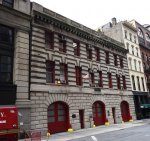
Another of Chief Crocker’s solutions to high-rise fires was the “salt water high pressure system” which provided an average of 125 pounds pressure to designated hydrants and could be raised to as high as 300 pounds. The area south of 14th Street was deemed the “high pressure district.” The system was fully operational by 1908—just in time for one of the two Duane Street companies’ worst nights.
January 7, 1909 was called by the New-York Tribune “a night of fires, twelve alarms being turned in in a little more than an hour.” The first alarm came at 7:22 when fire broke out in the Lipton Tea building at Hudson and Franklin Streets. According to the newspaper there were several explosions and “the neighborhood was aroused.” By the time the firefighters arrived, the entire building was engulfed.
Thirty-five minutes after Engine Company 7 began battling the blaze, the six-story wall of the Leonard Street side of the building collapsed “with a crash that could be heard for many blocks.” Eight firefighters from Engine Company 7 narrowly escaped with their lives.
In the meantime, a heavy north wind carried “sparks and three-inch cinders” as far south as Fulton Street, setting other buildings on fire. The firefighters contended not only with the winds, but with the bitter cold and problems with the high-pressure hoses.
The Tribune reported “It was a bad night for the firemen. The intense cold coated their clothing with a layer of ice, and icicles formed on their helmets and hair. A number of fire fighters were overcome by the combination of cold and heat and were attended by ambulance and department doctors.”
At the Lipton Tea fire the high-pressure hose broke free of the hydrant twice, “bowling men over.” The Tribune said “Many narrowly escaped serious injury.”
By the time the several fires were extinguished 18 companies had responded. The new high-pressure system was applauded. “For the first time since the installation of the high pressure system its efficiency was fully tested,” reported the Tribune. “Not one engine was used in fighting the fire, and the high pressure system again proved its efficiency.”
New York City was the center of the silent film industry at the time. The American Vitagraph Company occupied the second floor of the 12-story triangular Morton Building at Nassau and Ann Streets, where it stored around 1600 reels of highly-flammable celluloid film. The material was notorious for self-igniting in certain conditions—such as when it was near the hot bulbs of the motion picture projectors.
On Sunday afternoon, July 3, 1910, Charles A. Burton was working in the office when, around 5:15, he glanced into the storage room. The New-York Tribune reported the following day “Just as he did so, one of the hundred inflammable reels in the lot blazed up. He sprang for it and rushed with it to the window, throwing it out into Ann Street. Then, with his front hair, eyebrows and mustache singed to the skin, he turned back to look at the other films. They were a mass of flames where a moment before not a spark had appeared.”
The blaze rapidly spread upwards in the building. By the time Engine Company 7 and Hook & Ladder No. 1 responded to the narrow streets around the Morton Building workers were trapped. The Tribune noted that among them were five lawyers working for the Federal Investigation Bureau on the top floor. “When they poked their heads out of the windows they could see crawling swiftly up the airshaft toward them little tongues of flames, which crackled on the window casements.”
William T. Beck of Hook & Ladder No 1 and Joseph Wood, the driver of Engine Company 7, were already on the way up the stairs to the men. “When they got to the twelfth floor these firemen had to crawl on their hands and knees, the smoke was so dense,” said the newspaper. When the lawyers were told to follow them down the burning staircase, they were at first reticent. “But firemen can be very persuasive at times, and the five were guided in safety to the open air,” assured the article.
A “spectacular blaze” earlier that year did not end so happily. Fire erupted in the “bookbinder and paper ruler” operation of S. Wainkratz on the fourth floor of No. 70 Duane Street, just a block from the fire station, on April 23. The New-York Tribune reported “By the time the firemen arrived the fourth and fifth floors…were a mass of flames.”
Engine Company 7 was the first to arrive and put up its extension ladder to the fourth floor. Seven firefighters entered the building at street level; heading upwards “to open all the iron shutters they could get to,” according to The New York Times the following day. Suddenly they were overwhelmed by a back draft. The Tribune wrote “In an effort to get away [John] Fischer [sic] was lost. Somehow he succeeded in bursting open the iron shutters on the Manhattan alley side.”
The Times described the firefighter’s struggle in dramatic terms. “As for Fisher, his run for life was full of agonizing pain. Everything around him on the third floor was blazing, and smoke closed in around him, slowly benumbing his senses. He shouted for help, but there was no one to hear him. No one will ever know how many times he fell, then struggled up, and staggered on toward a window.”
Firefighters on the ground saw Fisher at the window, his clothing on fire. They yelled to hang on just for a moment and they would turn the water on him. But the desperate man threw himself out the window to the pavement below. His skull was fractured along with several other bones.
In the crowd was Father Gilroy of St. Andrew’s Church. He pushed through and administered last rites to the dying man who everyone thought was the building’s watchman. He was so burned that not even his fellow firefighters realized it was him. At the hospital his clothing was removed. “There they found his badge and learned from that who he was,” reported The Times.
Six other firefighters of Engine Company No. 7 were treated for injuries in what the New-York Tribune called “one of the most spectacular fires in the downtown districts for some time.”
By 1913 New York City was plagued with anarchist groups like the Black Hand which used terrorism to further their causes. As is the case today, certain firefighters were trained in anti-terrorism procedures, including the detection of explosive devices. Fireman William Scofield of Engine Company 7 was responsible for inspections of public venues in the downtown district.
Around 10:30 on the night of April 11, 1913 he began his inspection of the new Jefferson Theatre at No. 214 East 14th Street. About 1,500 patrons were enjoying a “motion picture love story,” according to The Times, while a man played a “soft accompaniment” to the silent movie on the piano.
Scofield was below the auditorium. He heard a “whispering, sputtering sound” which he recognized as something burning. Searching in the shadowy basement, he found a bomb, the fuse of which was sparking and rapidly burning toward the device. There was about a six inch length of fuse left before the explosion would take place.
The Times reported “Without making any outcry Scofield dropped to one knee, picked the bomb up in his hands, and put the fuse to his mouth. His teeth closed over the short stretch of fuse left and he bit it off clean. By doing so he checked the advance of the fire upon the explosive within and thereby probably saved the theatre from destruction and those within it from death or injury.”
Scofield’s method of disarming the bomb was, perhaps, unorthodox, but effective. While the movie goers continued to enjoy the film unaware, police arrived on the scene, including Detective Carrao, a specialist in bombs. An examination of the device made the intentions of its maker clear. On the plain brown paper in which it was wrapped was written Morte, the Italian word for “death.”
The Times noted that Scofield “makes such rounds every half-hour, being one of the firemen regularly detailed to theatres.” He advised the reporter that he “bit off the fuse as a surer and safer way than tearing at it, or attempting to put it out with his fingers, for it might have been dangerous for him to have tugged at the bomb in any way.”
The members of Engine Company No. 7 and Hook & Ladder No 1 were regularly recognized for their courage and action. On June 24, 1914 Captain Patrick Walsh was awarded a medal for saving Lieutenant Schoener from “the midst of several hundred barrels of flaming gasoline,” for instance, and on May 24, 1948 Lieutenant Henry J. Hermann was cited for his “extreme bravery in risking your own life to carry from a burning and smoke-filled building an aged woman who had been overcome.”
By 1927 the companies on Duane Street were sharing the fire station with First Division Headquarters, commanded by Deputy Chief James W. Hefferman. Hefferman was not only a veteran firefighter but an engineer and inventor whose improvements to firefighting equipment were in general use. In May 1927 he received the Fire Department’s Administration Medal for yet another invention.
Fire Commissioner Dorman described it to reporters as “a powerful new revolving nozzle, composed of six small nozzles, for use in ships or cellars where smoke or flames prevent firemen from entering with their hose.” The innovative device could be lowered into the burning space and the revolving nozzle would douse the entire area without the need for firefighters entering the space.

Following the Pearl Harbor attack and the United States entrance into World War II, a new threat existed for Manhattan. On February 8, 1942 Fire Commissioner Patrick Walsh (the same Walsh who had been cited for courageous performance when here in 1914) announced that “a new type of fire apparatus…developed for wartime emergencies” had been developed. “It will be known as hose Relay Apparatus 1 and will have its headquarters at Engine 7, at 100 Duane Street.”
The “hose relay wagon” was a converted aerial ladder truck. The racks and ladders had been removed, providing space for more than a half mile of three and a half inch hose. The new apparatus had seven times the capacity of the standard hose wagon. Should water mains be disabled by enemy attack, the modified wagon would be used to relay water pumped by fireboats.
In 1956 the First Division Headquarters moved to No. 243 Lafayette Street and in May 1957 the Hook & Ladder No. 1 moved to the center bay to make way for the Fire Department Museum. As a group of firefighters pushed an old engine pumper into the building on April 30, an “irreverent passerby,” according to The Times, yelled “Get a horse!” The pumper was one of 11 pieces of antique apparatus moved into the space, including an 1810 “gooseneck” fire engine. The museum was opened here on June 17 that year and remained until 1987 when it moved to No. 278 Spring Street.
Trowbridge & Livingston took inspiration from 17th century French architects who, in turn, had borrowed from Italian Renaissance designers.
Hook & Ladder 1 and Engine Company 7 continued to coexist in the building throughout the rest of the 20th century. In 2001 a French filmmaker, Jules Naudet, stationed himself at No. 100 Duane Street in order to create a documentary which followed the routine of a new firefighter, known as a “probie,” during his probationary period.
On the morning of September 11 Naudet was taping Battalion Chief Joe Pfeifer as he responded to a report of a gas leak. The sound of an airliner could be heard in the background. Naudet panned his camera upward just as the plane collided with the north tower of the World Trade Center.

The subsequent footage included the only known filmed documentation from inside the Trade Centers. The raw videotape was described by Times journalist Alan Feurer who said in part “It captures the radio transmissions ordering everyone down to the lobby after the second plane hits. It shows the gout of dust and rubble as the buildings suddenly collapse. It shows the booted foot of a Fire Department chaplain who is being carried through smoke and the din of screaming. It shows the faces of anxious men only minutes before they die.”
Later author David Friend in his 2006 book “Watching the World Change: The Stories Behind the Images of 9/11” said “Many would come to refer to Engine 7 as “Lucky 7”. In fire Department parlance, 100 Duane Street became the Miracle house: every one of its fifty-five firefighters—including the thirteen on duty that morning and the forty-two who rushed to assist them—escaped alive, thanks in no small measure to Joseph Pfeifer’s decisiveness.”
Pfeifer, the man whom Jules Naudet was filming with the catastrophe began, ordered fire fighters to the cleared C staircase of the north tower, saving them critical minutes in their descent and most likely saving their lives. Tragically, Pfeifer’s firefighter brother, Kevin, was lost that day.
Times reporter David W. Dunlap later noted “Everyone in the Fire Department lost incalculably on Sept. 11, 2001. The men of Engine Company 10 and Ladder Company 10 lost one thing more: their home.”
While their firehouse on Liberty Street was rebuilt, Engine 10 moved into No. 100 Duane Street where they remained until October 2003.
While many other companies were relocated throughout their existence, Ladder Company 1 and Engine Company 7 still remain in their striking 1905 firehouse. According to Paul Porcello, “Engine 7 is known as ‘The Magnificent Seven’, a reference to the western movie of the same name, based on the idea that at the time, the inside of the firehouse looked like the old west from when the department used horses to draw the apparatus. Ladder 1 is known as, "The Original One", for both being one of the first fire companies in the city, but for also being the first Tower Ladder in the FDNY in 1964.” He adds, “Together, the entire house is known as the ‘Stately Duane Manor,’ a play on the phrase ‘stately Wayne Manor’ from the old Batman TV show.”
The bronze letters “1 LADDER 1” were added to the central bay when the company moved from the western (right) bay to make way for the Fire Museum.
Trowbridge & Livingston’s exceptional design earned the structure landmark designation in 1993, and prompted the AIA Guide to New York City to call it “among the most impressive small-scale civic structures of the period.”
http://daytoninmanhattan.blogspot.com/2016/07/hook-ladder-1-engine-company-7-no-100.html
100 DUANE STREET FIREHOUSE - HISTORY
Hook & Ladder 1 / Engine Company 7 -- No. 100 Duane Street

By the turn of the last century Hook & Ladder Company No. 1 and Engine Company No. 7 had had an unusually close relationship for decades. The separate companies had been located nearby one another since the organization of the professional fire department in 1865 when they were housed steps away at Nos. 22 and 26 Chambers Street. Hook & Ladder No. 1, for instance, had a telegraph receiver at No. 22, while Engine Company No. 7 did not. Messages were run back and forth by fire fighters between the two companies to solve the problem.
But the histories of the companies went much further back. Hook & Ladder Company No. 1 was established during British rule, on July 10, 1772. After many of its volunteer members marched off to fight in the Revolution, it was reorganized in 1784 and given the name “Mutual Hook & Ladder No. 1.” It was Mutual Hook & Ladder No. 1’s foreman who designed the fireman’s helmet with the high crown and broad rear brim in the late 1820s. It is still used today with some variations.
Around 1830, not long after John W. Towt designed the helmet, the Protector Engine Company No. 22 was formed. Firefighting at the time relied on a disorganized collection of volunteer companies manned by neighborhood men called “laddies.” Many of the companies earned a reputation as rowdy, boisterous groups; and nearby fire houses would compete with one another to arrive at a fire first, or to become the more skilled at extinguishing it.
The devastating fire that destroyed Barnum’s Museum in 1865 along with pressure on the State Assembly by reformers resulted in the Act of 1865 that coupled Brooklyn and New York with a paid, united “Metropolitan District” fire department. Hook & Ladder No. 1 was unique among all the city’s companies. It not only was allowed to keep its name and number; but according to firefighter and department historian Paul Porcello, it “continued with the same truck, same helmets, same location, and nine of the new twelve members had served in the old volunteer company.”
Protector Engine Company No. 22 was reorganized as the professional Engine Company No. 7 and was installed at No. 26 Chambers Street close to Hook & Ladder No. 1. The companies would be relocated several times; always remaining together or close by.
As the turn of the century neared, a new challenge faced the Fire Department—the ever-growing height of downtown buildings. The steam pumper engines could shoot water no higher than a few stories; a problem that was made clear on December 4, 1898. Engine Company No. 7 and Hook & Ladder No. 1 both responded to a massive blaze in the five-story Rogers Peet menswear store at Broadway and Warren Street. The devastating fire sparked serious discussion about the how to more successfully battle high-rise fires. Among Chief Edward F. Croker’s solutions was to double-up the apparatus of engine companies. By adding a second truck the linked engines could achieve more thrust. His plan was initiated in 1904.
To accommodate its second engine, a new fire house was necessary for Engine Company No. 7. Three lots were acquired at Nos. 100 through 104 Duane Street and the old commercial buildings demolished.
From 1879 to 1895 Napoleon LeBrun & Sons had the enviable position as official architects to the New York City Fire Department and created sometimes opulent fire houses throughout the city. Now the Tammany Hall awarded commissions to various architectural firms. The esteemed firm of Trowbridge & Livingston was commissioned to design the new joint station of Engine Company 7 and Hook & Ladder Company No. 1.
Construction was completed a year later and the companies moved in on New Year’s Eve 1905. Trowbridge & Livingston had produced an especially handsome French Renaissance structure of red brick with heavy stone banding above a rusticated limestone base. The 75-foot wide structure featured three bay doors—two for Engine Company 7’s apparatus; and the other for Hook & Ladder No. 1. The second floor housed the two companies; while the uppermost story was reserved for municipal use, including a courthouse.
Within a week of the impressive building’s opening, on January 5, 1906, The Sun explained “Engine 7 has been made a double company, in order to afford better service in case of a fire in the dry goods district.”

Another of Chief Crocker’s solutions to high-rise fires was the “salt water high pressure system” which provided an average of 125 pounds pressure to designated hydrants and could be raised to as high as 300 pounds. The area south of 14th Street was deemed the “high pressure district.” The system was fully operational by 1908—just in time for one of the two Duane Street companies’ worst nights.
January 7, 1909 was called by the New-York Tribune “a night of fires, twelve alarms being turned in in a little more than an hour.” The first alarm came at 7:22 when fire broke out in the Lipton Tea building at Hudson and Franklin Streets. According to the newspaper there were several explosions and “the neighborhood was aroused.” By the time the firefighters arrived, the entire building was engulfed.
Thirty-five minutes after Engine Company 7 began battling the blaze, the six-story wall of the Leonard Street side of the building collapsed “with a crash that could be heard for many blocks.” Eight firefighters from Engine Company 7 narrowly escaped with their lives.
In the meantime, a heavy north wind carried “sparks and three-inch cinders” as far south as Fulton Street, setting other buildings on fire. The firefighters contended not only with the winds, but with the bitter cold and problems with the high-pressure hoses.
The Tribune reported “It was a bad night for the firemen. The intense cold coated their clothing with a layer of ice, and icicles formed on their helmets and hair. A number of fire fighters were overcome by the combination of cold and heat and were attended by ambulance and department doctors.”
At the Lipton Tea fire the high-pressure hose broke free of the hydrant twice, “bowling men over.” The Tribune said “Many narrowly escaped serious injury.”
By the time the several fires were extinguished 18 companies had responded. The new high-pressure system was applauded. “For the first time since the installation of the high pressure system its efficiency was fully tested,” reported the Tribune. “Not one engine was used in fighting the fire, and the high pressure system again proved its efficiency.”
New York City was the center of the silent film industry at the time. The American Vitagraph Company occupied the second floor of the 12-story triangular Morton Building at Nassau and Ann Streets, where it stored around 1600 reels of highly-flammable celluloid film. The material was notorious for self-igniting in certain conditions—such as when it was near the hot bulbs of the motion picture projectors.
On Sunday afternoon, July 3, 1910, Charles A. Burton was working in the office when, around 5:15, he glanced into the storage room. The New-York Tribune reported the following day “Just as he did so, one of the hundred inflammable reels in the lot blazed up. He sprang for it and rushed with it to the window, throwing it out into Ann Street. Then, with his front hair, eyebrows and mustache singed to the skin, he turned back to look at the other films. They were a mass of flames where a moment before not a spark had appeared.”
The blaze rapidly spread upwards in the building. By the time Engine Company 7 and Hook & Ladder No. 1 responded to the narrow streets around the Morton Building workers were trapped. The Tribune noted that among them were five lawyers working for the Federal Investigation Bureau on the top floor. “When they poked their heads out of the windows they could see crawling swiftly up the airshaft toward them little tongues of flames, which crackled on the window casements.”
William T. Beck of Hook & Ladder No 1 and Joseph Wood, the driver of Engine Company 7, were already on the way up the stairs to the men. “When they got to the twelfth floor these firemen had to crawl on their hands and knees, the smoke was so dense,” said the newspaper. When the lawyers were told to follow them down the burning staircase, they were at first reticent. “But firemen can be very persuasive at times, and the five were guided in safety to the open air,” assured the article.
A “spectacular blaze” earlier that year did not end so happily. Fire erupted in the “bookbinder and paper ruler” operation of S. Wainkratz on the fourth floor of No. 70 Duane Street, just a block from the fire station, on April 23. The New-York Tribune reported “By the time the firemen arrived the fourth and fifth floors…were a mass of flames.”
Engine Company 7 was the first to arrive and put up its extension ladder to the fourth floor. Seven firefighters entered the building at street level; heading upwards “to open all the iron shutters they could get to,” according to The New York Times the following day. Suddenly they were overwhelmed by a back draft. The Tribune wrote “In an effort to get away [John] Fischer [sic] was lost. Somehow he succeeded in bursting open the iron shutters on the Manhattan alley side.”
The Times described the firefighter’s struggle in dramatic terms. “As for Fisher, his run for life was full of agonizing pain. Everything around him on the third floor was blazing, and smoke closed in around him, slowly benumbing his senses. He shouted for help, but there was no one to hear him. No one will ever know how many times he fell, then struggled up, and staggered on toward a window.”
Firefighters on the ground saw Fisher at the window, his clothing on fire. They yelled to hang on just for a moment and they would turn the water on him. But the desperate man threw himself out the window to the pavement below. His skull was fractured along with several other bones.
In the crowd was Father Gilroy of St. Andrew’s Church. He pushed through and administered last rites to the dying man who everyone thought was the building’s watchman. He was so burned that not even his fellow firefighters realized it was him. At the hospital his clothing was removed. “There they found his badge and learned from that who he was,” reported The Times.
Six other firefighters of Engine Company No. 7 were treated for injuries in what the New-York Tribune called “one of the most spectacular fires in the downtown districts for some time.”
By 1913 New York City was plagued with anarchist groups like the Black Hand which used terrorism to further their causes. As is the case today, certain firefighters were trained in anti-terrorism procedures, including the detection of explosive devices. Fireman William Scofield of Engine Company 7 was responsible for inspections of public venues in the downtown district.
Around 10:30 on the night of April 11, 1913 he began his inspection of the new Jefferson Theatre at No. 214 East 14th Street. About 1,500 patrons were enjoying a “motion picture love story,” according to The Times, while a man played a “soft accompaniment” to the silent movie on the piano.
Scofield was below the auditorium. He heard a “whispering, sputtering sound” which he recognized as something burning. Searching in the shadowy basement, he found a bomb, the fuse of which was sparking and rapidly burning toward the device. There was about a six inch length of fuse left before the explosion would take place.
The Times reported “Without making any outcry Scofield dropped to one knee, picked the bomb up in his hands, and put the fuse to his mouth. His teeth closed over the short stretch of fuse left and he bit it off clean. By doing so he checked the advance of the fire upon the explosive within and thereby probably saved the theatre from destruction and those within it from death or injury.”
Scofield’s method of disarming the bomb was, perhaps, unorthodox, but effective. While the movie goers continued to enjoy the film unaware, police arrived on the scene, including Detective Carrao, a specialist in bombs. An examination of the device made the intentions of its maker clear. On the plain brown paper in which it was wrapped was written Morte, the Italian word for “death.”
The Times noted that Scofield “makes such rounds every half-hour, being one of the firemen regularly detailed to theatres.” He advised the reporter that he “bit off the fuse as a surer and safer way than tearing at it, or attempting to put it out with his fingers, for it might have been dangerous for him to have tugged at the bomb in any way.”
The members of Engine Company No. 7 and Hook & Ladder No 1 were regularly recognized for their courage and action. On June 24, 1914 Captain Patrick Walsh was awarded a medal for saving Lieutenant Schoener from “the midst of several hundred barrels of flaming gasoline,” for instance, and on May 24, 1948 Lieutenant Henry J. Hermann was cited for his “extreme bravery in risking your own life to carry from a burning and smoke-filled building an aged woman who had been overcome.”
By 1927 the companies on Duane Street were sharing the fire station with First Division Headquarters, commanded by Deputy Chief James W. Hefferman. Hefferman was not only a veteran firefighter but an engineer and inventor whose improvements to firefighting equipment were in general use. In May 1927 he received the Fire Department’s Administration Medal for yet another invention.
Fire Commissioner Dorman described it to reporters as “a powerful new revolving nozzle, composed of six small nozzles, for use in ships or cellars where smoke or flames prevent firemen from entering with their hose.” The innovative device could be lowered into the burning space and the revolving nozzle would douse the entire area without the need for firefighters entering the space.

Following the Pearl Harbor attack and the United States entrance into World War II, a new threat existed for Manhattan. On February 8, 1942 Fire Commissioner Patrick Walsh (the same Walsh who had been cited for courageous performance when here in 1914) announced that “a new type of fire apparatus…developed for wartime emergencies” had been developed. “It will be known as hose Relay Apparatus 1 and will have its headquarters at Engine 7, at 100 Duane Street.”
The “hose relay wagon” was a converted aerial ladder truck. The racks and ladders had been removed, providing space for more than a half mile of three and a half inch hose. The new apparatus had seven times the capacity of the standard hose wagon. Should water mains be disabled by enemy attack, the modified wagon would be used to relay water pumped by fireboats.
In 1956 the First Division Headquarters moved to No. 243 Lafayette Street and in May 1957 the Hook & Ladder No. 1 moved to the center bay to make way for the Fire Department Museum. As a group of firefighters pushed an old engine pumper into the building on April 30, an “irreverent passerby,” according to The Times, yelled “Get a horse!” The pumper was one of 11 pieces of antique apparatus moved into the space, including an 1810 “gooseneck” fire engine. The museum was opened here on June 17 that year and remained until 1987 when it moved to No. 278 Spring Street.
Trowbridge & Livingston took inspiration from 17th century French architects who, in turn, had borrowed from Italian Renaissance designers.
Hook & Ladder 1 and Engine Company 7 continued to coexist in the building throughout the rest of the 20th century. In 2001 a French filmmaker, Jules Naudet, stationed himself at No. 100 Duane Street in order to create a documentary which followed the routine of a new firefighter, known as a “probie,” during his probationary period.
On the morning of September 11 Naudet was taping Battalion Chief Joe Pfeifer as he responded to a report of a gas leak. The sound of an airliner could be heard in the background. Naudet panned his camera upward just as the plane collided with the north tower of the World Trade Center.

The subsequent footage included the only known filmed documentation from inside the Trade Centers. The raw videotape was described by Times journalist Alan Feurer who said in part “It captures the radio transmissions ordering everyone down to the lobby after the second plane hits. It shows the gout of dust and rubble as the buildings suddenly collapse. It shows the booted foot of a Fire Department chaplain who is being carried through smoke and the din of screaming. It shows the faces of anxious men only minutes before they die.”
Later author David Friend in his 2006 book “Watching the World Change: The Stories Behind the Images of 9/11” said “Many would come to refer to Engine 7 as “Lucky 7”. In fire Department parlance, 100 Duane Street became the Miracle house: every one of its fifty-five firefighters—including the thirteen on duty that morning and the forty-two who rushed to assist them—escaped alive, thanks in no small measure to Joseph Pfeifer’s decisiveness.”
Pfeifer, the man whom Jules Naudet was filming with the catastrophe began, ordered fire fighters to the cleared C staircase of the north tower, saving them critical minutes in their descent and most likely saving their lives. Tragically, Pfeifer’s firefighter brother, Kevin, was lost that day.
Times reporter David W. Dunlap later noted “Everyone in the Fire Department lost incalculably on Sept. 11, 2001. The men of Engine Company 10 and Ladder Company 10 lost one thing more: their home.”
While their firehouse on Liberty Street was rebuilt, Engine 10 moved into No. 100 Duane Street where they remained until October 2003.
While many other companies were relocated throughout their existence, Ladder Company 1 and Engine Company 7 still remain in their striking 1905 firehouse. According to Paul Porcello, “Engine 7 is known as ‘The Magnificent Seven’, a reference to the western movie of the same name, based on the idea that at the time, the inside of the firehouse looked like the old west from when the department used horses to draw the apparatus. Ladder 1 is known as, "The Original One", for both being one of the first fire companies in the city, but for also being the first Tower Ladder in the FDNY in 1964.” He adds, “Together, the entire house is known as the ‘Stately Duane Manor,’ a play on the phrase ‘stately Wayne Manor’ from the old Batman TV show.”
The bronze letters “1 LADDER 1” were added to the central bay when the company moved from the western (right) bay to make way for the Fire Museum.
Trowbridge & Livingston’s exceptional design earned the structure landmark designation in 1993, and prompted the AIA Guide to New York City to call it “among the most impressive small-scale civic structures of the period.”
http://daytoninmanhattan.blogspot.com/2016/07/hook-ladder-1-engine-company-7-no-100.html
Last edited:
Engine 7/Ladder 1/Battalion 1 (continued)
LADDER 1

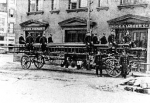



ENGINE 7/LADDER COMPANY 1 HISTORY
By Mike Boucher S.I. CO
It is uncertain when this three bay, 3 story fire house was erected. Some sources' state it was built in 1849 or 1850, others say it was built in 1852. All the sources do agree it was built for Protector Engine 22, Pearl Hose 28, and Mutual Ladder 1. Engine 22 was placed in service on June 25, 1840 with an address of 26 Chambers Street. In A. J. Costello 's book “Our Firemen” he reports that Engine 22 moved to new quarters in 1849. The old firehouse at 26 Chambers had to be torn down for this new building and Engine 22 must have moved to another site. Pearl Hose 28 went in service on May 25, 1839, on Centre Street above Chambers Street and moved to Chambers Street during 1852. Mutual Ladder 1 was placed in service on June 16, 1784, and moved from Beaver Street & Broad Street on June 14, 1852. All three companies were disbanded on September 20, 1865 and replaced by the paid companies, which were placed in service on September 8th. Engine 22 was replaced by Engine 7.
Mutual Ladder 1 was replaced by Metropolitan Ladder 1, which is the only company that can trace it roots back to 1784. Both Ladder 1's have served the people of New York City faithfully for over 200 hundred years without any interruption. Ladder 1 is the only paid company to have the same number as the volunteer department, in the same house and with most of the same members. Battalion 2 was placed in service here on January 1, 1869.
The Fire Department used only the first floor, with the top two floors being used for a court house. On November 8, 1875, the courts moved to the third floor and on January 19,1876, the members of Engine 7 and Ladder 1 were relocated into temporary living quarters across the street at 12 Centre Street. The second floor of the fire house was rebuilt into quarters and the members moved back to Chambers Street on February 19, 1876.
Chemical Engine 8 was added to Ladder 1's quarters on October 23, 1876, and became part of Ladder 1 on August 15, 1877.
After a couple of years the court moved out and the members had all three floors for their use. New York’s first water tower was placed in service here on July 2, 1879. Battalion 2 moved into temporary quarters with Engine 31 at 68 Lafayette Street on April 1, 1894. The Water Tower moved to new quarters along with Engine 31 to 87 Lafayette Street on June 3, 1896.
A lot for a new fire station was picked out at Park Row and Chambers Street in July of 1897 for Engine 7 and Ladder 1. For an unknown reason the lot was not used by the Fire Department. New quarters were built for Engine 32 at 49 Beekman Street and Engine 7 moved in here instead of Engine 32 on June 15, 1903. Engine 7's part of the Chambers Street quarters were torn down for the building of the Independent Rapid Transit Subway Line. Ladder 1 moved out to new quarters at 100 Duane Street on December 31, 1905. The building was torn down and the land is now a park.
LINE OF DUTY DEATHS:
Engine 7
FF. Francis Reilly 1892
FF. John Reinhardt was overcome by smoke at 161-163 Chambers St. on May 6, 1897.
Ladder 1
FF. Thomas Dougherty died when a wall fell at 384-386 Broadway on Feb. 20, 1880, Box 33-120.
FF. John Cassidy died when a wall fell at 384-386 Broadway on Feb. 20, 1880, Box 33-120.
FF. James C. O’Shaunessy crushed his leg at 203 Broadway and it was amputated on Apr. 11, 1887, He died from blood poisoning on May 11, 1877. Box 44.
Battalion 2
Assistant Foreman George A. Erlacher was thrown from the apparatus in front of 183 Water St. while responding to Peck Slip & Water Street on Feb. 9, 1873.
APPARATUS:
Engine 7
1866 Amoskeag 2nd size steamer, #148, Sep. 8, 1965.
1865 Amoskeag hose tender.
1868 Amoskeag 2nd size steamer in 1869
1872 FDNY hose tender, #31.
1880 Clapp & Jones 1st size steamer, #352, Nov. 1880. Rebuilt in Sep. 1894.
1888 Gleason & Bailey hose tender, #81.
1896 Gleason & Bailey hose wagon, #52.
Chemical Engine 8
1876 Woodbridge Smith upright chemical engine, 2 wheel, 1 horse pulled chemical engine
Ladder 1
1865 Charles E. Hartshorn ladder truck.
1869 FDNY Shops 65ft ladder truck, #6, Dec. 1869.
1892 Rumsey & Co. 75ft ladder truck #39, 1892
Water Tower 1
1879 Greenleaf 50ft hoist, #1, Jul. 2, 1879.
1882 Greenleaf 50ft hoist, #2, Dec. 28, 1982
1885 Greenleaf/FEMCO, #3
1895 Hale/FEMCO, 65ft #6,
MEDAL WINNERS:
Engine 7
Capt. Thomas A. Kenny, Stephenson Medal, 1888.
Ladder 1
Lt. Minthorne D. Tompkins, James Gordon Bennett Medal, Nov. 14, 1869.
FF. Thomas Hutchinson, James Gordon Bennett Medal, Nov. 20, 1872.
FF. Thomas J. Dougherty, James Gordon Bennett Medal, Mar. 31, 1876.
Capt. Peter H. Short, James Gordon Bennett Medal, Feb. 21, 1885.
Capt. John S. Honan, Stephenson Medal, 1890.
https://nyfd.com/history/ladder_1.two.html
LADDER 1





ENGINE 7/LADDER COMPANY 1 HISTORY
By Mike Boucher S.I. CO
It is uncertain when this three bay, 3 story fire house was erected. Some sources' state it was built in 1849 or 1850, others say it was built in 1852. All the sources do agree it was built for Protector Engine 22, Pearl Hose 28, and Mutual Ladder 1. Engine 22 was placed in service on June 25, 1840 with an address of 26 Chambers Street. In A. J. Costello 's book “Our Firemen” he reports that Engine 22 moved to new quarters in 1849. The old firehouse at 26 Chambers had to be torn down for this new building and Engine 22 must have moved to another site. Pearl Hose 28 went in service on May 25, 1839, on Centre Street above Chambers Street and moved to Chambers Street during 1852. Mutual Ladder 1 was placed in service on June 16, 1784, and moved from Beaver Street & Broad Street on June 14, 1852. All three companies were disbanded on September 20, 1865 and replaced by the paid companies, which were placed in service on September 8th. Engine 22 was replaced by Engine 7.
Mutual Ladder 1 was replaced by Metropolitan Ladder 1, which is the only company that can trace it roots back to 1784. Both Ladder 1's have served the people of New York City faithfully for over 200 hundred years without any interruption. Ladder 1 is the only paid company to have the same number as the volunteer department, in the same house and with most of the same members. Battalion 2 was placed in service here on January 1, 1869.
The Fire Department used only the first floor, with the top two floors being used for a court house. On November 8, 1875, the courts moved to the third floor and on January 19,1876, the members of Engine 7 and Ladder 1 were relocated into temporary living quarters across the street at 12 Centre Street. The second floor of the fire house was rebuilt into quarters and the members moved back to Chambers Street on February 19, 1876.
Chemical Engine 8 was added to Ladder 1's quarters on October 23, 1876, and became part of Ladder 1 on August 15, 1877.
After a couple of years the court moved out and the members had all three floors for their use. New York’s first water tower was placed in service here on July 2, 1879. Battalion 2 moved into temporary quarters with Engine 31 at 68 Lafayette Street on April 1, 1894. The Water Tower moved to new quarters along with Engine 31 to 87 Lafayette Street on June 3, 1896.
A lot for a new fire station was picked out at Park Row and Chambers Street in July of 1897 for Engine 7 and Ladder 1. For an unknown reason the lot was not used by the Fire Department. New quarters were built for Engine 32 at 49 Beekman Street and Engine 7 moved in here instead of Engine 32 on June 15, 1903. Engine 7's part of the Chambers Street quarters were torn down for the building of the Independent Rapid Transit Subway Line. Ladder 1 moved out to new quarters at 100 Duane Street on December 31, 1905. The building was torn down and the land is now a park.
LINE OF DUTY DEATHS:
Engine 7
FF. Francis Reilly 1892
FF. John Reinhardt was overcome by smoke at 161-163 Chambers St. on May 6, 1897.
Ladder 1
FF. Thomas Dougherty died when a wall fell at 384-386 Broadway on Feb. 20, 1880, Box 33-120.
FF. John Cassidy died when a wall fell at 384-386 Broadway on Feb. 20, 1880, Box 33-120.
FF. James C. O’Shaunessy crushed his leg at 203 Broadway and it was amputated on Apr. 11, 1887, He died from blood poisoning on May 11, 1877. Box 44.
Battalion 2
Assistant Foreman George A. Erlacher was thrown from the apparatus in front of 183 Water St. while responding to Peck Slip & Water Street on Feb. 9, 1873.
APPARATUS:
Engine 7
1866 Amoskeag 2nd size steamer, #148, Sep. 8, 1965.
1865 Amoskeag hose tender.
1868 Amoskeag 2nd size steamer in 1869
1872 FDNY hose tender, #31.
1880 Clapp & Jones 1st size steamer, #352, Nov. 1880. Rebuilt in Sep. 1894.
1888 Gleason & Bailey hose tender, #81.
1896 Gleason & Bailey hose wagon, #52.
Chemical Engine 8
1876 Woodbridge Smith upright chemical engine, 2 wheel, 1 horse pulled chemical engine
Ladder 1
1865 Charles E. Hartshorn ladder truck.
1869 FDNY Shops 65ft ladder truck, #6, Dec. 1869.
1892 Rumsey & Co. 75ft ladder truck #39, 1892
Water Tower 1
1879 Greenleaf 50ft hoist, #1, Jul. 2, 1879.
1882 Greenleaf 50ft hoist, #2, Dec. 28, 1982
1885 Greenleaf/FEMCO, #3
1895 Hale/FEMCO, 65ft #6,
MEDAL WINNERS:
Engine 7
Capt. Thomas A. Kenny, Stephenson Medal, 1888.
Ladder 1
Lt. Minthorne D. Tompkins, James Gordon Bennett Medal, Nov. 14, 1869.
FF. Thomas Hutchinson, James Gordon Bennett Medal, Nov. 20, 1872.
FF. Thomas J. Dougherty, James Gordon Bennett Medal, Mar. 31, 1876.
Capt. Peter H. Short, James Gordon Bennett Medal, Feb. 21, 1885.
Capt. John S. Honan, Stephenson Medal, 1890.
https://nyfd.com/history/ladder_1.two.html
Last edited:
Engine 7/Ladder 1/Battalion 1 (continued)
Engine 7/Ladder 1/Battalion 1:
https://www.youtube.com/watch?v=3g_A_Qm24Q8
https://www.youtube.com/watch?v=VgnTo3VekVw
WTC
https://www.youtube.com/watch?v=NI3KFI7gm2M
Engine 7/Ladder 1/Battalion 1:
https://www.youtube.com/watch?v=3g_A_Qm24Q8
https://www.youtube.com/watch?v=VgnTo3VekVw
WTC
https://www.youtube.com/watch?v=NI3KFI7gm2M
Last edited:
Engine 7/Ladder 1/Battalion 1 (continued)
WATER TOWER 1
Located at 100 Duane Street 1879-1896:
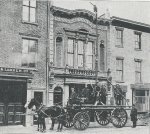
Water Tower units were developed to place high caliber streams into upper floors from an elevated position. The 1st water tower was developed in Baltimore and placed in service at Engine 7 in 1879. It was manufactured by Greenleaf and had a 50 foot mast. Water towers remained in operation in FDNY until 1959 when replaced by ladder pipes.
SMOKE EJECTOR 1
Located at 100 Duane Street 1941-1957:

Smoke Ejector units were developed by FDNY to improve operations in heavy smoke environments such as cellar fires. Before self-contained breathing apparatus was developed, the Smoke Ejector units successfully reduced smoke with large exhaust mechanisms. They also carried foam powder. Both Smoke Ejector units ran on converted city service trucks. By 1956, FDNY companies had self-contained breathing apparatus and the Smoke Ejector units were disbanded.
Smoke Ejector 1 was located at Engine 7.
WATER TOWER 1
Located at 100 Duane Street 1879-1896:

Water Tower units were developed to place high caliber streams into upper floors from an elevated position. The 1st water tower was developed in Baltimore and placed in service at Engine 7 in 1879. It was manufactured by Greenleaf and had a 50 foot mast. Water towers remained in operation in FDNY until 1959 when replaced by ladder pipes.
SMOKE EJECTOR 1
Located at 100 Duane Street 1941-1957:

Smoke Ejector units were developed by FDNY to improve operations in heavy smoke environments such as cellar fires. Before self-contained breathing apparatus was developed, the Smoke Ejector units successfully reduced smoke with large exhaust mechanisms. They also carried foam powder. Both Smoke Ejector units ran on converted city service trucks. By 1956, FDNY companies had self-contained breathing apparatus and the Smoke Ejector units were disbanded.
Smoke Ejector 1 was located at Engine 7.
Last edited:


